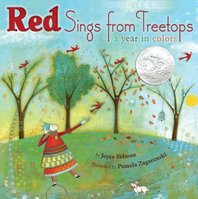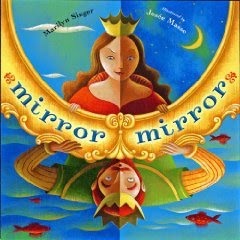
Red sings from treetops: a year in colors by Joyce Sidman, illustrated by Pamela Zagarenski
Houghton Mifflin, 2009
As a rule, I am not a lover of poetry. The only book of poetry I remember enjoying as a child is Shel Silverstein's Where the sidewalk ends due to its wit, creativity, and occasional weirdness, which fails to explain why I attempted to slog through Sir Walter Scott's epic The Lady of the Lake a few years later. In between, my grade 9 English teacher's apparent obsession with The cremation of Sam McGee by Robert Service drove me batty - there is something about the rhythm and rhyme that I didn't like - and I haven't read that blasted poem since. The thing is, if there were poetry books like Red sings from treetops when I was young, I would probably not be so averse to the genre.
Sidman essentially weaves a tale of the colours of the seasons in a narrative told in verse. There is a sequential nature to the poems as later poems tie back to earlier ones: poems about white all describe it as a sound, and poems about green follow its prevalence throughout the seasons. This flow of the poems ties in nicely with the flow of the seasons and as a group as well as individually, the poems are lovely. There is no set rhyming scheme, length, or rhythm, so the poems vary but none are more than 10-12 lines.
Zagarenski's illustrations are stunning. They are a combination of mixed media paintings on wood and computer illustration, and are magical. All the people and animals who make their way through the seasons wear crowns, even the snowman. I find it difficult to describe Zagarenski's style here, as she combines patterns and textures and pasted newsprint in a way I have never seen before. It certainly lends an air of fantasy to the poems, and I am curious if she uses the same techniques in other books.
Lovely to read and beautiful to look at.
Houghton Mifflin, 2009
As a rule, I am not a lover of poetry. The only book of poetry I remember enjoying as a child is Shel Silverstein's Where the sidewalk ends due to its wit, creativity, and occasional weirdness, which fails to explain why I attempted to slog through Sir Walter Scott's epic The Lady of the Lake a few years later. In between, my grade 9 English teacher's apparent obsession with The cremation of Sam McGee by Robert Service drove me batty - there is something about the rhythm and rhyme that I didn't like - and I haven't read that blasted poem since. The thing is, if there were poetry books like Red sings from treetops when I was young, I would probably not be so averse to the genre.
Sidman essentially weaves a tale of the colours of the seasons in a narrative told in verse. There is a sequential nature to the poems as later poems tie back to earlier ones: poems about white all describe it as a sound, and poems about green follow its prevalence throughout the seasons. This flow of the poems ties in nicely with the flow of the seasons and as a group as well as individually, the poems are lovely. There is no set rhyming scheme, length, or rhythm, so the poems vary but none are more than 10-12 lines.
Zagarenski's illustrations are stunning. They are a combination of mixed media paintings on wood and computer illustration, and are magical. All the people and animals who make their way through the seasons wear crowns, even the snowman. I find it difficult to describe Zagarenski's style here, as she combines patterns and textures and pasted newsprint in a way I have never seen before. It certainly lends an air of fantasy to the poems, and I am curious if she uses the same techniques in other books.
Lovely to read and beautiful to look at.

 RSS Feed
RSS Feed